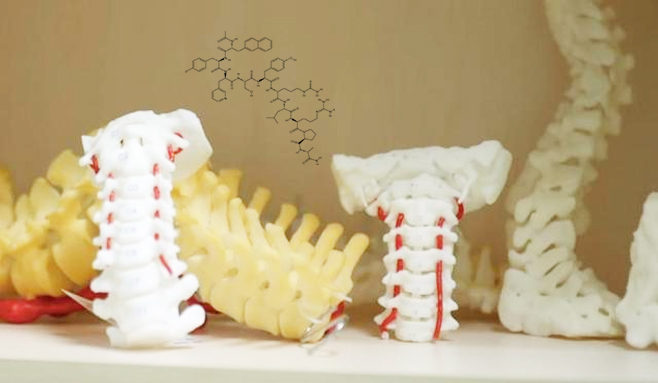Self-assembled Peptides Help With Bone Repair
With the prevalence of high-intensity sports activities and the intensification of population aging, there are millions of patients with bone injuries caused by various reasons every year, especially those over the age of 60. Osteoporosis directly leads to an increase in fracture rates.
In addition, as age increases, the function of angiogenesis, lymphatic circulation, and progenitor cells in the fracture site decreases, which limits the self repair function of damaged bone tissue, leading to an extended course of disease. Long term bed rest can easily lead to complications such as bedsores, lung infections, urinary tract infections, limb vein thrombosis, etc. In severe cases, thrombus detachment can lead to fatal diseases such as cerebral infarction, stroke, and myocardial infarction. This has led to a sharp increase in medical and socio-economic costs related to bone trauma, posing a serious burden on patients.
Therefore, finding a treatment strategy that can quickly repair damaged bone tissue and shorten the patient's course of disease has important clinical significance.
Article category: Biomedical, pharmaceutical research and development
Keywords: bone repair, self-assembled polypeptide, peptide hydrogel
Clinical Treatment Plans for Bone Defects
At present, the treatment of bone defects in clinical practice mainly includes: autologous or allogeneic bone transplantation, scaffold fixation, ceramics, bioglass, bone cement, demineralized bone matrix, polymer filling, etc.
However, factors such as immune rejection and infection severely limit the clinical application of transplantation. According to the World Health Organization, less than 10% of patients worldwide are able to successfully undergo transplant surgery.
In addition, traditional biomaterials such as ceramics, bioglass, and bone cement have limited promoting effects on bone regeneration due to their lack of osteogenic induction. Therefore, developing biomaterials with osteogenic induction is an important development direction for promoting bone regeneration.

Self-assembled Peptide Hydrogel Appears
Self assembling polypeptide hydrogel provides an efficient treatment method for bone tissue repair with its advantages of high bionic artificial extracellular matrix structure, low immunogenicity, easy synthesis and modification, and flexible drug loading.
The porosity and permeability of the gel delivery system can not only be used as a space filler and a delivery medium for bioactive molecules to promote the growth of tissues and cells; It can also be equipped with various functions to promote bone regeneration by providing a microenvironment for cell homing and inducing osteoblast differentiation and tissue formation; Drugs can also be loaded to directly act on bone defect sites, improving the bioavailability of drugs.
In addition, the bone repair gel can be administered locally in the bone defect by minimally invasive means, closely fitting with the bone defect, and becoming a research hotspot of the bone repair delivery system.
Self-assembling Peptide Molecules Are Ideal Scaffolds for Tissue Engineering
The matrix of the injectable gel delivery system currently studied is mostly composed of gelatin, alginate, hyaluronic acid, sulfate cartilage, polyethylene glycol, and polyvinyl alcohol.
Compared with traditional materials, self-assembled polypeptide molecules are assembled into stable structures through various non covalent interactions. Their formation process is from molecules to nanofibers to the final hydrogel network, which usually shows hierarchical microstructure.
Moreover, the structure of self-assembled polypeptide hydrogels is similar to that of extracellular matrix (ECM), and the degradation rate is compatible with the growth rate of many tissues. It is an ideal scaffold for tissue engineering.
By designing and regulating polypeptide sequences, it is possible to achieve good responsiveness to external stimuli (pH, temperature, pressure, etc.) and target recognition, which endow peptide gel materials with unique advantages in the field of drug delivery as drug carriers.
In addition, peptides also have the advantages of simple synthesis, easy functional modification and easy removal or reabsorption of degradation products (amino acids), becoming a new star in the research of gel delivery systems.
Application of Self-assembled Peptide Gel in Bone Repair
Self-assembled peptide hydrogels can mimic extracellular matrices, facilitate cell adhesion and migration, and have the advantages of low immunogenicity, easy to load a variety of cells and bioactive substances. They have been widely used to deliver stem cells, osteoblasts, chondrocytes, endothelial cells, and a variety of osteoblasts or factors.
In addition, hydrogels can also enhance the mechanical properties of hydrogels by adding different nano fillers. It exhibits good osteogenic performance both in vivo and in vitro.
As an emerging biomaterial, self-assembled peptides have excellent biocompatibility, injectability, low immunogenicity, and the ability to flexibly load cells, proteins, and small molecule drugs, making them shine in the field of bone regeneration.
However, bone regeneration is a complex process, which is affected by many factors. Based on the flexible and diverse loading performance and bionic performance of gel, peptide hydrogel is used to simultaneously load a variety of stem cells and active factors to play the role of multi strategy synergy.
FAQs: What is a Self-assembled Peptide?
Self assembly is a common phenomenon in nature, such as the formation of cell membranes, protein folding, and DNA double helix structure, which is one of the most important components in life sciences. By imitating protein structures with self-assembly functions, various biomimetic peptides with assembly functions can be designed. In addition to biomimetic design, de novo design is also the main approach for self-assembly peptide design.
The structure of self-assembled peptides includes: peptide amino acid sequences, i.e. primary structures, as well as secondary structures formed by intramolecular interactions between adjacent amino acids, such as α- Spiral β- Folding and irregular curling, as well as molecular assembly with specific folding structures formed between peptide molecules. The amino acid types and sequences of peptides are the basis for assembly formation.
Visit Omizzur Biotech
Omizzur is a company engaged in peptide and impurity synthesis, visit us: www.omizzur.com
Inquiry: [email protected]
Copyright © 2020 Omizzur Inc | Terms & Conditions | Privacy Notice | Sitemap